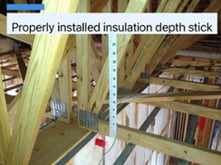 Blown-in insulation installers know that measuring it in an attic is key to delivering the required thermal performance and receiving a Grade I install. That is typically accomplished by installing attic rulers throughout the space, so there is one for every 300 sq. feet of attic space. Accurate measures are needed to meet code requirements, according to Chris Conway, President of Conway Energy, a building science consulting firm that specializes in single and multi-family construction. No matter how experienced the installer is, you’re going to want to measure every time and check in multiple locations. But there are times when that measurement can be off.
Blown-in insulation installers know that measuring it in an attic is key to delivering the required thermal performance and receiving a Grade I install. That is typically accomplished by installing attic rulers throughout the space, so there is one for every 300 sq. feet of attic space. Accurate measures are needed to meet code requirements, according to Chris Conway, President of Conway Energy, a building science consulting firm that specializes in single and multi-family construction. No matter how experienced the installer is, you’re going to want to measure every time and check in multiple locations. But there are times when that measurement can be off.
Intentional Under-blowing (the Measures)
Conway says an installer may not accurately measure the insulation’s depth. “This can happen in new construction if the insulation depth ruler is cut short or the bottom is folded over,” he said. “It’s hard for me to imagine a scenario where anything other than the installer trying to shave a few inches of insulation off the agreed upon and contracted amount would be the cause,” Conway added.
For contractors working on retrofitting insulation in existing homes where there is already some insulation, an installer would slide the ruler through the insulation and estimate when they hit the drywall ceiling. “Of course, they could do their due diligence and move the insulation out of the way to they can see the drywall, but that may not often happen since it can easily be 130 to 140 degrees in there, so speed is essential. In the process of guessing when the ruler truly hits the drywall ceiling, the contractor could theoretically push the ruler a few inches past that location,” he told us. “But any installer paying attention shouldn’t have that problem.”
Though under-blowing of insulation could happen, a trustworthy and diligent contractor isn’t likely to make that mistake, especially in a new home setting.
Validation is Key (the Checks)
Just because the insulation should be there at the required thickness doesn’t mean it will be. If a builder is working with a contractor, Conway advises that the insulation levels be checked to verify thickness. Typically, he says, this can be done by one of four people:
Builder/General Contractor: In new construction, the builder or general contractor has paid for a specific amount of insulation, but they should never trust that it is there without verifying, Conway says. “I think the biggest issue for the builders is that they rely too heavily on the insulation contractor and are unaware that matters like this can happen.”
Code Official: “In my opinion, insulation depth should always be spot verified by a code official, and their measurements should then be compared to the insulation depth rulers,” Conway advised. “Any discrepancy should be noted and corrected before they approve the home.”
Green Building/Energy Rater: If the builder is working with an energy rater, the rater should be checking to verify the required insulation is there, and if the depth wasn’t sufficient, this is something that a diligent rater would catch. “The only other possible scenario would be if the program they were administering allowed inspections to be performed under a sampling protocol, meaning they may only need to verify 1 out of 7 homes. Undoubtedly, sampling is a double-edged sword.”
Home Inspector: “Most home inspectors that I work with spot-check insulation depth, and they could notice a discrepancy between their measurement and the insulation depth ruler. This discrepancy should be noted on their report and addressed before the owner purchases the home,” Conway said.
The Result
Missing or inadequate insulation could lead to several problems, Conway added, including comfort issues. In addition, the HVAC system in the home may not be designed to satisfy the increased heating/cooling demands. This means that the system would be working harder than it should. “Even if the HVAC is sized to match the load, the supply feeding the room/area may not be large enough to handle the amount of air required to offset the temperature difference.”
Using rulers to properly measure blown-in insulation throughout the attic space and having a point person check to ensure that the depth is correct can eliminate these potential issues.





